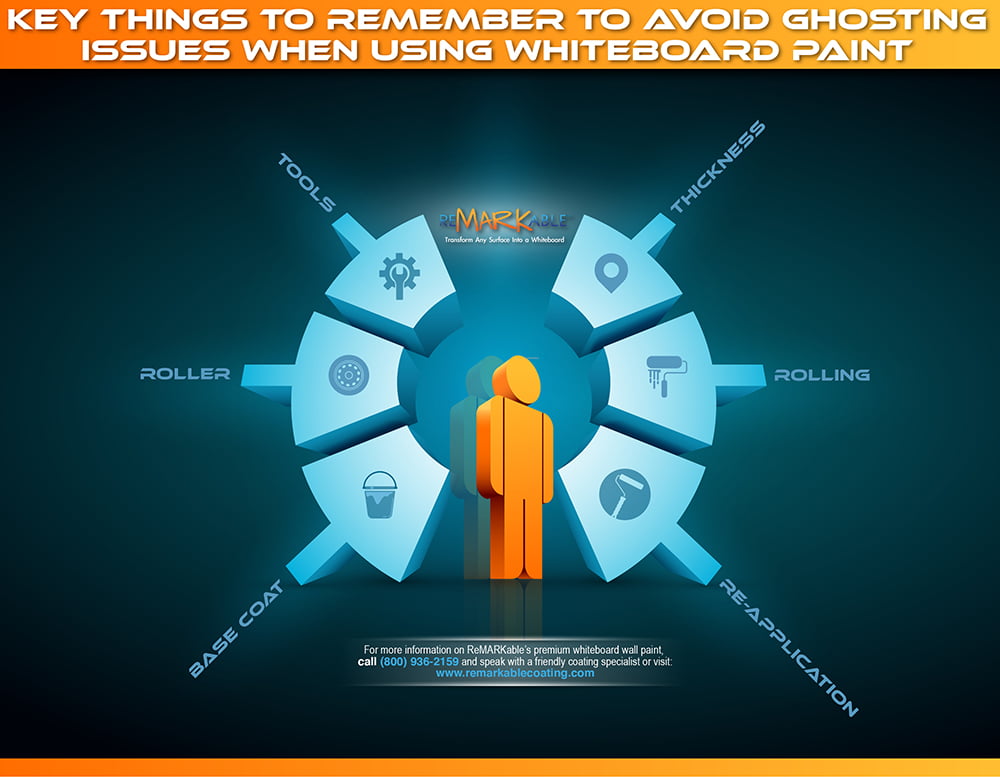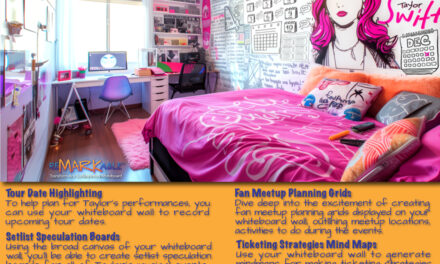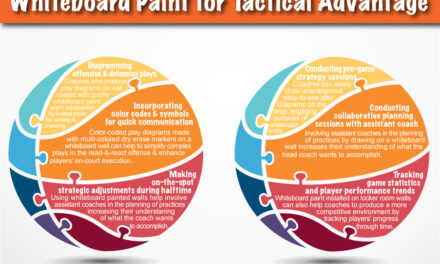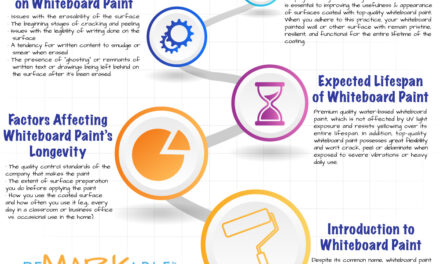
Key Things to Remember to Avoid Ghosting Issues when Using Whiteboard Paint
Introduction: Ghosting is the process by which the surface of a traditional whiteboard or a whiteboard painted wall fails to erase completely, leaving behind gray cloudy-looking stains and stray dry erase ink markings that can make the surface unsightly and hard to read from. Factors that can eliminate ghosting on a whiteboard coated surface include (1) application of a compatible base coat; (2) use of a proper type of paint roller sleeve; (3) application in one even coat;(4) use of low-odor dry erase markers for writing and a microfiber cloth for cleaning; and (5) avoidance of back rolling or re-rolling of the whiteboard coating.
Whiteboard Base Coat Paint
Before installing our premium whiteboard coatings, use either Remarkable Tintable Base Paint or the recommended high-quality satin or water-based eggshell enamel as the base coat. When such base coats are applied, they provide the proper underlayment for our premium coatings because they allow the coatings to lie on their surfaces, as coatings should, instead of soaking down into them. In contrast, due to their highly absorbent nature, other less expensive and/or lower quality base coats such as latex house paints with a flat or matte sheen will cause the whiteboard paint to soak in. This produces a finished whiteboard surface that is more permeable than it should be so that dry erase marker ink is able to sink in and cause ghosting or areas of gray with the faint traces or “ghosts” of what was recently written and erased.
It’s also necessary to avoid base paints that contain the chemical polyvinyl acetate (PVAc) or other ingredients such as anti-mildew agents, anti-fungal agents, and several other additives described in the fourth answer of our official web site’s FAQ section titled, “How do I prepare my surface before applying ReMARKable?” As these paints dry, the chemicals give off gases and need air to dry completely, so if you use such a base paint, the impermeable surface of our whiteboard coating will trap the gases, resulting in irregularities and unevenness, which in turn lead to issues with writability, erasability, and maintenance. For this reason, it’s safest to use our proprietary tintable base paint as your undercoat because its chemical formula is entirely compatible with the formula of our whiteboard coatings and so will provide the ideal foundation for your whiteboard surface.
Whiteboard Wall Roller
Be sure to use the prescribed high-quality 1/4″ or 3/8″ nap microfiber paint roller sleeve for proper application of the whiteboard coating. Doing so will produce a smooth, even whiteboard surface and will avoid an uneven or textured finish when the coating dries. If you were to use a 3/4″ roller sleeve instead, you would be able to hold much more whiteboard paint at one time. Still, you would also end up with a textured “orange peel” surface where dry erase marker ink would collect in the tiny low places or crevices, causing smudging and ghosting and thus making your whiteboard coated wall more difficult to write on, erase, and maintain.
Also, remember to purchase the best quality roller frame and microfiber cover that you can afford because they will last longer than cheaper products and give you a much smoother whiteboard finish. Inexpensive roller covers might easily disintegrate and leave lint behind in your coating, thus producing an irregular whiteboard surface where smudging and ghosting would occur because marker ink would get stuck in the tiny nooks and crannies of the surface and be difficult to remove. Also, since microfiber paint roller sleeves are extremely effective at absorbing paints or coatings and at holding onto them until you’re ready to roll, your chances of causing spattering are significantly reduced. Thus, to produce the proper results for your whiteboard coating installation, you need to use the best roller covers possible.
Whiteboard Paint Thickness
Avoid trying to stretch the material too thin; for example, don’t attempt to paint cover 50 square feet of wall surface with a 35-square-foot kit. Instead, buy two 35-square-foot kits so that you’ll cover your whole surface and have some paint left over to do another project. Apply the whiteboard paint in one even coat over just the amount of square footage that your kit was designed to cover and no more. Attempting to extend the area covered with the coating will produce places where insufficient material has been installed. This, in turn, will cause irregularities in the finished surface and problems with writing, erasing, and cleaning once the coating has dried. Spreading the coating out too thinly will also produce an unsightly spotty appearance and a surface that will be impractical to maintain over time. Stretching is common practice in applying regular house paint or other types of paint but should not be tried with our products, which are really coatings, not paints, and are formulated to be installed in a single even layer.
Whiteboard Surface Tools
Use low-odor dry erase markers to write and draw on your whiteboard wall and a microfiber cloth, towel, or mitt to erase your marker ink. Compared to markers that emit strong, unpleasant odors, low-odor whiteboard markers are specially formulated to be more eco-friendly, to produce uniform, easily visible lines, and to erase them neatly. The formulas of many dry erase markers include a noxious blend of components, but the ingredient that you should most definitely avoid is methyl isobutyl ketone, also known as hexone. Research has shown that when this chemical is inhaled, it is toxic to the liver, kidneys, and nervous system and irritating to the mucous membranes of the nose, mouth, throat, and lungs, and may cause lightheadedness and confusion. Hexone may also be carcinogenic. Thus, it’s wise to simply avoid using dry erase markers that are not labeled “low odor” and choose a low-odor brand that will be free of such toxic chemicals.
Regarding microfiber cloths, towels, and mitts, they have a fantastic capacity to trap and hold onto dirt and grime such as dry erase marker ink, so they can leave your whiteboard painted surface spotlessly clean and easy to write and draw on for many years of use. The incredibly small fibers in these materials can attach themselves to the tiny, invisible particles of dirt that the fibers of normal fabrics such as cotton can’t pick up. This is possible because there are many more fibers in one piece of microfiber fabric than in other types of fabric, so the forces of attraction between microfibers and specks of dirt are multiplied countless times. Thus, we recommend microfiber fabric as the only way to truly make your whiteboard surface clean and useable.
Dry Erase Paint Rolling
Do not overwork or excessively back roll or roll-off an area after it has already been coated. Although this practice is common when applying standard types of paint such as latex wall paint, it should not be attempted when installing premium whiteboard coatings because back rolling damages the fine endothermic film that’s produced during the first pass with the paint roller, and this film needs to remain intact if you want to achieve a smooth, impermeable whiteboard surface that will last for ten-plus years and be easy to write on, erase, and maintain.
Whiteboard Paint Re-application
Do not go back to an area where you have already gone across the surface once and add more whiteboard coating afterward. Doing so will result in an inconsistent or uneven sheen and can cause less than favorable results when you write on, erase, and clean your whiteboard-coated surface. Since our whiteboard paints are actually coatings and not paints, they require a different method of application; namely, rolling on with a 1/4″ or 3/8″ microfiber paint roller in one even coat with no re-application, as you might do with other types of paints. As the whiteboard coating is applied, a film is quickly formed that must be carefully maintained throughout the installation process. If you try to re-apply coating on top of a previously coated area, this film will be disturbed, and the whiteboard surface’s impermeability and durability will be compromised.


























































































![ReMARKable’s Winter Sale is Here! [25% Off + Free Shipping]](https://www.remarkablecoating.com/wp-content/uploads/2018/01/Red-Tag-Winter-Fashion-Facebook-Post-1-440x264.png)















![Drive Your Organization Into Openness and Watch it Expand [20% Off Whiteboard Paint]](https://www.remarkablecoating.com/wp-content/uploads/2016/04/Drive-Your-Organization-Into-Openness-and-Watch-It-Expand.-1-440x264.jpg)

![30% Off St Patrick’s Day Sale! [Details Inside]](https://www.remarkablecoating.com/wp-content/uploads/2016/03/Glorious-1-440x264.png)


![Giant Leaps Forward Require Big Spaces. [Leap Year Sale Event!]](https://www.remarkablecoating.com/wp-content/uploads/2016/02/Giant-Leaps-ForwardRequire-Big-Spaces-440x264.jpg)

















![ReMARKable Summer Sale 2018 [28% Off Whiteboard Paint]](https://www.remarkablecoating.com/wp-content/uploads/2018/06/Blue-Simple-Line-Beach-Facebook-Post-1-440x264.png)




































































































































































































0 Comments